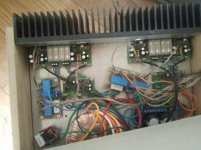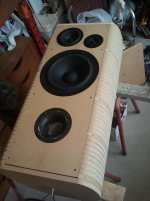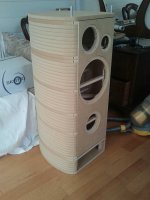I'm plodding towards making a stereo pair of 3-way speakers with active crossovers and 3x amps per speaker, and am starting to think seriously about the physical setup.
I had originally intended to build the crossovers and amps into the speakers, but it could be better to build the electronics (amps and crossovers etc) into a separate box of their own and have 6-way speaker/power cable leading off to the speakers. This should make tinkering with the electronics and/or speaker cabinets easier, and would mean I could make the speakers and electronics/heat-sinks whatever sizes I wanted, they wouldn't need to fit each other. I'd also then have just one low(ish) voltage power cable to run to the speakers, albeit a chunky one, rather than trailing mains (and signal) leads to them. I'd probably want to use 6-way (or 8-way) connectors to ensure i couldn't mess up which channel went to which speaker and they aren't exactly cheap by the looks of it, but an integrated box could save by sharing things like soft start & speaker protection circuitry and signal-level power supplies etc.
Does this seem reasonable, or are there penalties I haven't thought of by moving the active crossovers and amps away from the speakers?
Cheers
Kev
I had originally intended to build the crossovers and amps into the speakers, but it could be better to build the electronics (amps and crossovers etc) into a separate box of their own and have 6-way speaker/power cable leading off to the speakers. This should make tinkering with the electronics and/or speaker cabinets easier, and would mean I could make the speakers and electronics/heat-sinks whatever sizes I wanted, they wouldn't need to fit each other. I'd also then have just one low(ish) voltage power cable to run to the speakers, albeit a chunky one, rather than trailing mains (and signal) leads to them. I'd probably want to use 6-way (or 8-way) connectors to ensure i couldn't mess up which channel went to which speaker and they aren't exactly cheap by the looks of it, but an integrated box could save by sharing things like soft start & speaker protection circuitry and signal-level power supplies etc.
Does this seem reasonable, or are there penalties I haven't thought of by moving the active crossovers and amps away from the speakers?
Cheers
Kev
Hmm, yes two separate boxes would be a possibility. It would negate some of the possible savings of sharing a box, but I can see there may be fewer problems with crosstalk and probably grounding were I to keep everything separate.
Is there a reason you would put them close to the speakers? It may be nice to see the results of my work so I'm not averse to that, though they would need to look presentable if they weren't hidden away somewhere.
The CAT5 idea is most helpful, I've probably even got some
Cheers
Kev
Is there a reason you would put them close to the speakers? It may be nice to see the results of my work so I'm not averse to that, though they would need to look presentable if they weren't hidden away somewhere.
The CAT5 idea is most helpful, I've probably even got some
Cheers
Kev
Close to speakers reduces significantly the length of cables and thus allows more consistent amplifier performance.
Long interconnects are much easier to design for. Simply adding a 50r resistor to the output of the Cable driving Source gets most of the way to a complete solution.
Long interconnects are much easier to design for. Simply adding a 50r resistor to the output of the Cable driving Source gets most of the way to a complete solution.
Ah, I see, thanks, I didn't realise there was much in it. But on reflection I can see it makes sense to keep the power side of things shorter and lower resistance if there's the option to do so. Assuming the balanced line does its job at avoiding noise and interference, it should also be cheaper and easier to run longer lengths of that instead.
Thanks
Kev
Thanks
Kev
Hi Kev, I house the amps in the bottom of the boxes on a sheet of 3 mm aluminium, on which the heat sink is mounted too. The whole assembly slides out for easy access, and it is out of the way (ie, not tripped over). Second image is the latest build.
Abs
Abs
Attachments
That looks like a good idea, Abs!
Yeah, if I'm going to have the amps right out by the speakers anyway it would save on an extra box and 6-way speaker cables. I'd just need to make sure (like you have done) that its easy to get to to the electronics.
EDIT: having done some measurements, my heat-sink is only about 2" wider than my 10" bass drivers, so its not going to make the cabinet much wider than absolutely necessary, and I hadn't been thinking of a narrow baffle in any case.
Cheers
Kev
Yeah, if I'm going to have the amps right out by the speakers anyway it would save on an extra box and 6-way speaker cables. I'd just need to make sure (like you have done) that its easy to get to to the electronics.
EDIT: having done some measurements, my heat-sink is only about 2" wider than my 10" bass drivers, so its not going to make the cabinet much wider than absolutely necessary, and I hadn't been thinking of a narrow baffle in any case.
Cheers
Kev
Last edited:
I'be been playing with fitting the active crossover, power supply and amps into a generic sort of speaker-shaped situation. It seems to fit, but on past performance i'm sure there will be all sorts of things i don't know wrt how best to do it.
Are there any good threads on the physical layout of something like this? For example don't put the torroid near certain things, or should I shield the crossovers in their own metal box, or route signal cables away from mains/speaker cables etc etc. Or if theres no existing thread people know of, are there any rules of thumb?
Thanks
kev
Are there any good threads on the physical layout of something like this? For example don't put the torroid near certain things, or should I shield the crossovers in their own metal box, or route signal cables away from mains/speaker cables etc etc. Or if theres no existing thread people know of, are there any rules of thumb?
Thanks
kev
Keep the low level (signal) wiring and boards as far away from AC mains and power transformer as possible, crossing mains lines at 90 degree angles if needed. You probably won't need to go as far as shielding your crossovers if signal wires are kept tightly twisted with their ground wires. Shielded wire would work but in my open air breadboard amps I found it wasn't necessary. Old Cat-5 cable as mentioned earlier is a handy source of good quality wire already nicely twisted for you.
All exposed metal parts need to be directly connected to mains earth for safety.
To help avoid ground loops connect your signal/amp power grounds to the mains ground through a diode bridge bypassed with an NTC (CL60 works well), as shown in many of the Pass designs. See page 11 here: http://firstwatt.com/pdf/art_f5_turbo.pdf
Most importantly, have fun and post a build thread.
All exposed metal parts need to be directly connected to mains earth for safety.
To help avoid ground loops connect your signal/amp power grounds to the mains ground through a diode bridge bypassed with an NTC (CL60 works well), as shown in many of the Pass designs. See page 11 here: http://firstwatt.com/pdf/art_f5_turbo.pdf
Most importantly, have fun and post a build thread.
Many thanks Bob, thats most helpful - as is the link too. The layout requirements seem fairly straight forward in concept then, although I realise real-world compromises may complicate things in practice. I've been trying to get my head around the many types of ground and earth involved and I think I'm getting there, but I may post questions later if I'm not sure.
Thanks for the encouragement as well! Fiddling about with the physical components has really awoken my interest again. I should probably just accept that I won't appreciate many of the subtleties at this stage; instead of dwelling on it all I should get on and actually build something. I'll definitely start a build thread when theres something to show
Cheers
Kev
Thanks for the encouragement as well! Fiddling about with the physical components has really awoken my interest again. I should probably just accept that I won't appreciate many of the subtleties at this stage; instead of dwelling on it all I should get on and actually build something. I'll definitely start a build thread when theres something to show
Cheers
Kev
Thanks, thats helpful and raises a point I should consider; I'd planned to just shove everything around the back to keep the aesthetics simple. But it could be better to have the gubbins accessible from the front, so perhaps I should make the effort to design for that that.
I guess a compromise may be to have them removable from the back, but on leads at least long enough to let them be placed somewhere comfortably accessible when required. Which would actually be like a temporary version of Andrew's suggestion of a separate amp box next to the speaker.
Hmm, perhaps I could have separate amp boxes and make them stackable or something, i.e. the amps could double as a speaker stand, a bit like designs in which the mid/tweeter box is separate to the bass enclosure.
Much to ponder!
Cheers
kev
I guess a compromise may be to have them removable from the back, but on leads at least long enough to let them be placed somewhere comfortably accessible when required. Which would actually be like a temporary version of Andrew's suggestion of a separate amp box next to the speaker.
Hmm, perhaps I could have separate amp boxes and make them stackable or something, i.e. the amps could double as a speaker stand, a bit like designs in which the mid/tweeter box is separate to the bass enclosure.
Much to ponder!
Cheers
kev
- Status
- This old topic is closed. If you want to reopen this topic, contact a moderator using the "Report Post" button.
- Home
- Amplifiers
- Solid State
- 3-way active x-over - physical setup?


